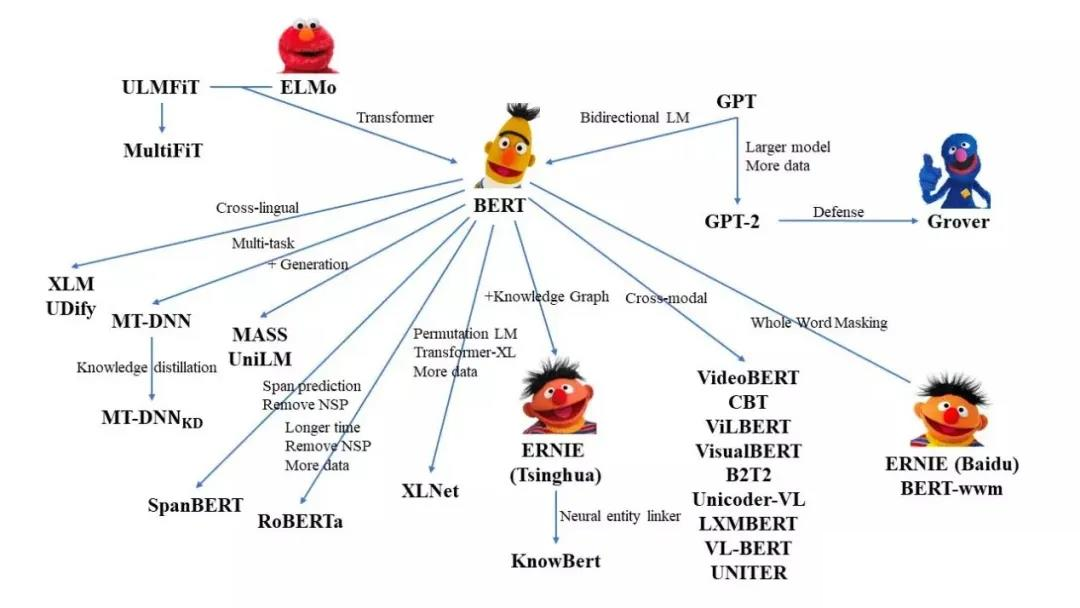BERT实战——(3)问答任务-多选问答
BERT实战——(3)问答任务-多选问答
引言
我们将展示如何使用 🤗 Transformers代码库中的模型来解决问答任务中的多选问答问题。
任务介绍
虽然叫多选问答,但实际上是指给出一个问题的多个可能的答案(备选项),选出其中一个最合理的,其实类似于我们平常做的单选题。该任务的实质同样是分类任务,在多个备选项中进行二分类,找到答案。
比如输入一句话的上半句,给出几个后半句的备选项,选出哪个选项是这个上半句的后半句:
输入:("离离原上草",["天安门一游","一岁一枯荣","春风吹又生"]) |
主要分为以下几个部分:
- 数据加载
- 数据预处理
- 微调预训练模型:使用transformer中的
Trainer接口对预训练模型进行微调。
前期准备
安装以下库:
pip install datasets transformers |
数据加载
数据集介绍
我们使用的数据集是SWAG。SWAG是一个关于常识推理的数据集,每个样本描述一种情况,然后给出四个可能的选项。
加载数据
该数据的加载方式在transformers库中进行了封装,我们可以通过以下语句进行数据加载:
from datasets import load_dataset |
如果你使用的是自己的数据,参考第一篇实战博客【定位词:加载数据】加载自己的数据。
如果上述代码数据集在下载过程中出现了一些问题,可以此链接下载数据并解压,将解压后的3个csv文件复制到代码目录下,然后用加载cache的方式进行加载:
import os |
给定一个数据切分的key(train、validation或者test)和下标即可查看数据。
datasets["train"][0] |
下面的函数将从数据集里随机选择几个例子进行展示:
from datasets import ClassLabel |
show_random_elements(datasets["train"]) |
| ending0 | ending1 | ending2 | ending3 | fold-ind | gold-source | label | sent1 | sent2 | startphrase | video-id | |
|---|---|---|---|---|---|---|---|---|---|---|---|
| 0 | are seated on a field. | are skiing down the slope. | are in a lift. | are pouring out in a man. | 16668 | gold | 1 | A man is wiping the skiboard. | Group of people | A man is wiping the skiboard. Group of people | anetv_JmL6BiuXr_g |
| 1 | performs stunts inside a gym. | shows several shopping in the water. | continues his skateboard while talking. | is putting a black bike close. | 11424 | gold | 0 | The credits of the video are shown. | A lady | The credits of the video are shown. A lady | anetv_dWyE0o2NetQ |
| 2 | is emerging into the hospital. | are strewn under water at some wreckage. | tosses the wand together and saunters into the marketplace. | swats him upside down. | 15023 | gen | 1 | Through his binoculars, someone watches a handful of surfers being rolled up into the wave. | Someone | Through his binoculars, someone watches a handful of surfers being rolled up into the wave. Someone | lsmdc3016_CHASING_MAVERICKS-6791 |
| 3 | spies someone sitting below. | opens the fridge and checks out the photo. | puts a little sheepishly. | staggers up to him. | 5475 | gold | 3 | He tips it upside down, and its little umbrella falls to the floor. | Back inside, someone | He tips it upside down, and its little umbrella falls to the floor. Back inside, someone | lsmdc1008_Spider-Man2-75503 |
可以看到,数据集中的每个示例都有一个上下文,它是由第一个句子(字段sent1)和第二个句子的简介(字段sent2)组成,并给出四种结尾句子的备选项(字段ending0, ending1, ending2和ending3),然后让模型从中选择正确的一个(由字段label表示)。
下面的函数让我们更直观地看到一个示例:
def show_one(example): |
数据预处理
在将数据喂入模型之前,我们需要对数据进行预处理。
仍然是两个数据预处理的基本流程:
- 分词;
- 转化成对应任务输入模型的格式;
Tokenizer用于上面两步数据预处理工作:Tokenizer首先对输入进行tokenize,然后将tokens转化为预模型中需要对应的token ID,再转化为模型需要的输入格式。
初始化Tokenizer
之前的博客已经介绍了一些Tokenizer的内容,并做了Tokenizer分词的示例,这里不再重复。use_fast=True指定使用fast版本的tokenizer。
from transformers import AutoTokenizer |
转化成对应任务输入模型的格式
这一类型任务的模型输入是什么呢?
事实上,我们应该将问题和备选项分别进行组合,相当于一个样本为输入备选项个数相同的句子对列表,如下所示:
[("Members of the procession walk down the street holding small horn brass instruments.","A drum line passes by walking down the street playing their instruments."), |
之前已经介绍过Tokenizer的输入可以是一个单句,也可以是两个句子。
那么显然在调用tokenizer之前,我们需要预处理数据集先生成输入Tokenizer的样本。
在preprocess_function函数中:
首先将样本中问题和备选项分别放在两个嵌套列表(两个嵌套列表分别存储了每个样本的问题和备选项)中;
比如,e1_sen1表示样本1的问题(相当于输入tokenizer的句子1),e1_sen2_1表示样本1的备选项1(相当于输入tokenizer的句子2).....
[[e1_sen1,e1_sen1,e1_sen1,e1_sen1],
[e2_sen1,e2_sen1,e2_sen1,e2_sen1],
[e3_sen1,e3_sen1,e3_sen1,e3_sen1]]
[[e1_sen2_1,e1_sen2_2,e1_sen2_3,e1_sen2_4],
[e2_sen2_1,e2_sen2_2,e2_sen2_3,e2_sen2_4],
[e3_sen2_1,e3_sen2_2,e3_sen2_3,e3_sen2_4]]然后将问题列表和备选项列表拉平Flatten(两个嵌套列表各自去掉嵌套),以便tokenizer进行批处理,以问题列表为例:
after flatten->
[e1_sen1,e1_sen1,e1_sen1,e1_sen1,
e2_sen1,e2_sen1,e2_sen1,e2_sen1,
e3_sen1,e3_sen1,e3_sen1,e3_sen1]
after Tokenize->
[e1_tokens1,e1_tokens1,e1_tokens1,e1_tokens1,
e2_tokens1,e2_tokens1,e2_tokens1,e2_tokens1,
e3_tokens1,e3_tokens1,e3_tokens1]经过tokenizer后,再转回每个样本有备选项个数输入id、注意力掩码等。
after unflatten->
[[e1_tokens1,e1_tokens1,e1_tokens1,e1_tokens1],
[e2_tokens1,e2_tokens1,e2_tokens1,e2_tokens1]
[e3_tokens1,e3_tokens1,e3_tokens1]]
参数truncation=True使得比模型所能接受最大长度还长的输入被截断。
代码如下:
ending_names = ["ending0", "ending1", "ending2", "ending3"] |
以上的预处理函数可以处理一个样本,也可以处理多个样本exapmles。如果是处理多个样本,则返回的是多个样本被预处理之后的结果list。
让我们解码一下给定示例的输入,可以看到一个样本对应四个问题和备选项合并的句子。
examples = datasets["train"][:5] |
接下来使用map函数对数据集datasets里面三个样本集合的所有样本进行预处理,将预处理函数prepare_train_features应用到(map)所有样本上。参数batched=True可以批量对文本进行编码。这是为了充分利用前面加载fast_tokenizer的优势,它将使用多线程并发地处理批中的文本。
tokenized_datasets = datasets.map(preprocess_function, batched=True) |
微调预训练模型
数据已经准备好了,我们需要下载并加载预训练模型,然后微调预训练模型。
加载预训练模型
做多项选择任务,那么需要一个能解决这个任务的模型类。我们使用AutoModelForMultipleChoice 这个类。
和之前几篇博客提到的加载方式相同不再赘述。
from transformers import AutoModelForMultipleChoice |
设定训练参数
为了能够得到一个Trainer训练工具,我们还需要训练的设定/参数 TrainingArguments。这个训练设定包含了能够定义训练过程的所有属性。
task='ner' |
数据收集器data collator
接下来需要告诉Trainer如何从预处理的输入数据中构造batch。我们使用数据收集器data collator,将经预处理的输入分batch再次处理后喂给模型。
由前面preprocess_function函数的输出我们可以看到,每个样本都还没有做padding,我们在data collator中按照batch将每个batch的句子padding到每个batch最长的长度。注意,因为不同batch中最长的句子不一定都和整个数据集中的最长句子一样长,也就是说不是每个batch都需要那么长的padding,所以这里不直接padding到最大长度,可以有效提升训练效率。
由于transformers库中没有合适的data collator来处理这样特定的问题,我们根据DataCollatorWithPadding稍作改动改编一个合适的。我在代码中补充了features和batch逐步转化的格式变化过程:
from dataclasses import dataclass |
在一个10个样本的batch上检查data collator是否正常工作。
在这里我们需要确保features中只有被模型接受的输入特征(但这一步在后面Trainer自动会筛选):
accepted_keys = ["input_ids", "attention_mask", "label"] |
然后让我们检查单个样本是否完整,利用之前的show_one函数进行对比,看来没错!
[tokenizer.decode(batch["input_ids"][8][i].tolist()) for i in range(4)] |
定义评估方法
我们使用'accuracy'对模型进行评估。
需要定义一个函数计算返回精度,取预测logits的argmax得到预测标签preds,和ground_truth进行进行对比,计算精度:
import numpy as np |
开始训练
将数据/模型/参数传入Trainer即可:
from transformers import Trainer |
调用train方法开始训练:
trainer.train() |

